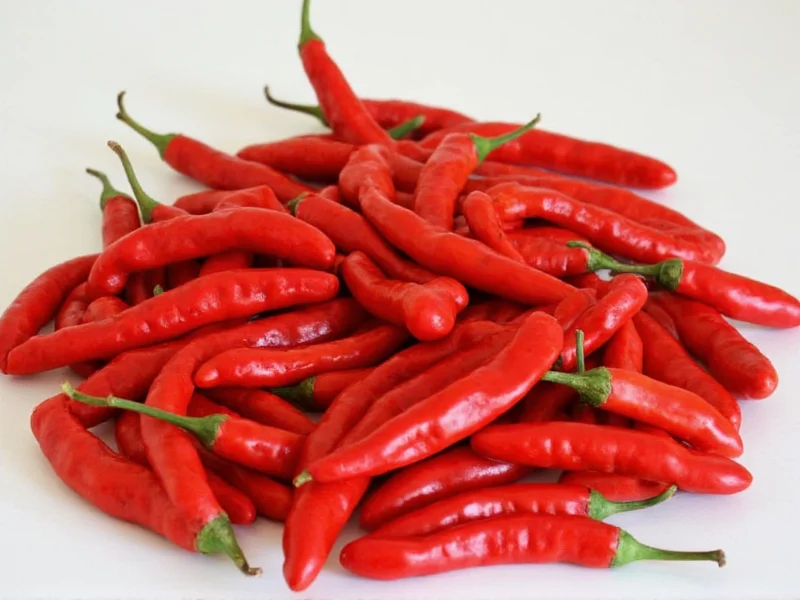If you're reaching for chile de arbol peppers only to find your spice cabinet empty, you're not alone. This slender, bright red Mexican chili appears in countless authentic recipes but can be challenging to source outside specialty markets. Understanding proper chile de arbol pepper substitutes ensures your dishes maintain authentic flavor and heat without compromising your cooking process. The key lies in matching both the Scoville heat units and distinctive smoky, slightly fruity flavor profile that makes chile de arbol so valued in Mexican cuisine.
Understanding Chile de Arbol Characteristics
Before selecting a substitute, recognize what makes chile de arbol unique. These 2-3 inch long dried peppers deliver 15,000-30,000 Scoville heat units—hotter than jalapeños but milder than habaneros. Their flavor combines bright fruitiness with subtle smokiness and earthy notes. Commonly used whole in salsas or ground into powders, they provide both heat and complex flavor to dishes like salsa roja, mole, and adobo sauces.
Top Chile de Arbol Pepper Substitutes Compared
| Substitute | Heat Level (Scoville) | Flavor Profile | Substitution Ratio | Best Applications |
|---|---|---|---|---|
| Cayenne pepper | 30,000-50,000 | Sharp, slightly smoky, clean heat | 1:1 (use 25% less for equal heat) | Sauces, marinades, dry rubs |
| Crushed red pepper flakes | 15,000-25,000 | Mixed heat with seed bitterness | 1.5:1 (1.5x amount) | Pasta dishes, pizza, quick sauces |
| Serrano peppers (fresh) | 10,000-25,000 | Grassy, bright, clean heat | 2:1 (double the amount) | Salsas, guacamole, fresh preparations |
| Guajillo peppers | 2,500-5,000 | Fruity, berry-like, mild heat | 3:1 (triple the amount) | Moles, stews, color-focused dishes |
| Thai bird chilies | 50,000-100,000 | Intense, sharp, floral heat | 0.5:1 (half the amount) | Asian-inspired fusion dishes |
Practical Substitution Guidelines
When replacing chile de arbol in your recipes, consider both heat intensity and flavor compatibility. For most Mexican dishes requiring dried chile de arbol, cayenne pepper provides the closest match. Though slightly hotter, its clean heat and similar flavor profile make it ideal for sauces and marinades. Reduce cayenne by 25% to match chile de arbol's heat level precisely.
Fresh serrano peppers work well when your recipe calls for fresh chiles. Their grassy brightness differs slightly from chile de arbol's earthiness, but they deliver comparable heat. Use two serranos for every chile de arbol called for, removing seeds to control heat. This substitution shines in fresh salsas and guacamole.
Crushed red pepper flakes offer kitchen convenience but require adjustment. Their mixed composition (seeds, membranes, and flakes) creates inconsistent heat. Use 1.5 times the amount of flakes compared to chile de arbol, and consider removing larger seeds for a cleaner flavor. This works particularly well in quick tomato-based sauces.
Advanced Substitution Techniques
For authentic flavor matching beyond simple heat replacement, combine substitutes strategically. When making salsa roja, blend equal parts cayenne and smoked paprika to replicate chile de arbol's signature smokiness. In mole sauces, pair guajillo peppers (for fruitiness) with a pinch of cayenne (for heat) to approximate chile de arbol's complexity.
Consider your dish's cooking time when substituting. Chile de arbol's flavor intensifies with prolonged cooking, while cayenne can become bitter. Add cayenne later in the cooking process for best results. For slow-cooked dishes like braises, use whole substitutes like dried árbol alternatives that can be removed before serving.
When substituting in baking applications—such as chocolate-chili desserts—opt for cayenne over fresh peppers. Its consistent heat distribution works better in dry ingredients. Start with half the recommended amount and adjust to taste, as baking concentrates heat.
Special Considerations for Specific Dishes
For salsas: Fresh serranos provide the best texture and bright heat. Remove seeds for milder salsa or include them for authentic chile de arbol intensity. Add lime juice to balance the slightly different flavor profile.
For adobo sauce: Combine cayenne with a touch of chipotle powder (⅛ teaspoon per teaspoon of cayenne) to replicate chile de arbol's subtle smokiness. This creates a more complex flavor profile suitable for braising meats.
For dry rubs: Use cayenne as a direct replacement but add ¼ teaspoon of toasted cumin per tablespoon to compensate for chile de arbol's earthy notes. This adjustment maintains the authentic Mexican spice profile.











 浙公网安备
33010002000092号
浙公网安备
33010002000092号 浙B2-20120091-4
浙B2-20120091-4